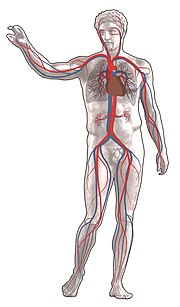Circulatory System

Outline of the cardiovascular system, showing major veins and arteries (red and blue) to the bloodstream
The circulatory system is the anatomical structure together comprising both leading and cardiovascular system circulates blood, as the lymphatic system that carries lymph.
Circulatory System Types
There are two types of circulatory systems:
Closed circulatory system: It consists of a series of blood vessels which, without leaving them, the blood travels. The material carried by the blood reaches the tissues through diffusion. It is characteristic of annelids, cephalopods and vertebrates.
Open circulatory system: The blood pumped by the heart travels through blood vessels, which supplies blood directly to the cells, returning by different mechanisms. This type of system is presented in arthropods and molluscs not cephalopods.
The blood circulation was discovered by the physician William Harvey.
Cardiovascular system in humans
Division circuit
This apparently made two circuits from the heart:
* Circulation greater or somatic or general circulation. The blood trail begins at the left ventricle of the heart, carrying oxygen, and extends through the aorta and arterial branches to the capillary system, where veins are formed that contain oxygen-poor blood. Flow into one of the two venae cavae (superior and inferior) that drain into the right atrium.
* Circulation lesser or pulmonary circulation or central. The oxygen-poor blood from the right ventricle side of the heart through the pulmonary artery branches into two separate trunks for each of both lungs. In pulmonary alveolar capillary blood is oxygenated through a process known as hematosis and is fed back through the four pulmonary veins draining the oxygen-rich blood in the left atrium of the heart.
* Blood circulation. Neither the general nor the pulmonary circuit are really though because blood from the heart and makes it back to it at different cavities. The real circle is closed when the blood passes from the left atrium to left ventricle. This explains that described by the pulmonary circulation by the physician Michael Servetus to the general circulation by William Harvey. Full Circle is: left ventricle - aorta - systemic arteries and capillaries - vena cava - right atrium - right ventricle - pulmonary artery - arteries and pulmonary capillary - pulmonary vein - left atrium and left ventricle end, where the circuit began. Interestingly when it was discovered that the movement could not yet see the capillaries and blood was thought to be consumed in the tissues.
* Circulation portal. Is a subtype of the general circulation of veins originated from a capillary system, which returns to form capillaries in the liver, the end of their journey. There are two portal systems in the human body:
1. Hepatic portal system: Veins originating in the capillaries of the digestive tract from stomach to rectum that carry the products of digestion, are converted back into capillaries in the liver sinusoids to form new veins that drain into the circulation system through the hepatic veins to the inferior vena cava.
2. Hypophyseal portal system: The superior hypophyseal artery from the internal carotid branches into a first network of capillaries located in the median eminence. From these capillaries are formed pituitary veins coming down the pituitary stalk and create a second network of capillaries in the anterior pituitary gland that drain into the internal jugular vein.
Blood circulation in other vertebrates
Circulation in fishes
Circulation incomplete appears in fish. This blood flow only passes once through the heart at every turn one can say that is simple. The heart is tubular and shows a venous sinus that collects the blood, an atrium and a ventricle driver. The blood comes from the veins of the body charged with Co to the heart. The ventricle pushes blood to the gills, which oxygenates and circulates through arteries to divide by the body. The return of blood to the heart through veins is performed.
The brachial artery, supplies blood to the gills for oxygenation. Therefore, the circulation in these animals is closed, simple and incomplete, ie there is only one circuit and there will be mixture of blood.
Circulation in amphibians
In the first lungfish Vertebrates (Amphibians and Reptiles no crocodilians) is the heart and thoracic position appears a double movement, since there is a smaller circuit or pulmonary vein that carries blood to the lungs and heart brings back the arterial blood from those, and larger circuit or general blood that carries blood to the body and brings back the venous blood to the heart.
In these animals the heart has three chambers: two atria (right and left) and a single ventricle, rather muscular. The right atrium receives venous blood from the rest of the body, and sends it to the ventricle to the pump to the lungs through the pulmonary artery. The left atrium receives arterial blood from the lungs, and it sends the ventricle pumps blood to the body through the aorta. Between the two arteries is a small tube called the ductus arteriosus. The atria contract in succession, so that the mixture of blood in the ventricle is small. Anyway, the double movement will be incomplete.
Circulation in reptiles
In crocodilians and reptiles there is a complete division of the ventricle into two compartments (left and right). Therefore, it is the heart and has two staffs tetracameral Aortic left leaving the right ventricle and carries venous blood, and the right leaving the left ventricle and carries blood pressure. It produces a very small mixture of blood in the descending aorta. Therefore, it is considered that the movement is incomplete.